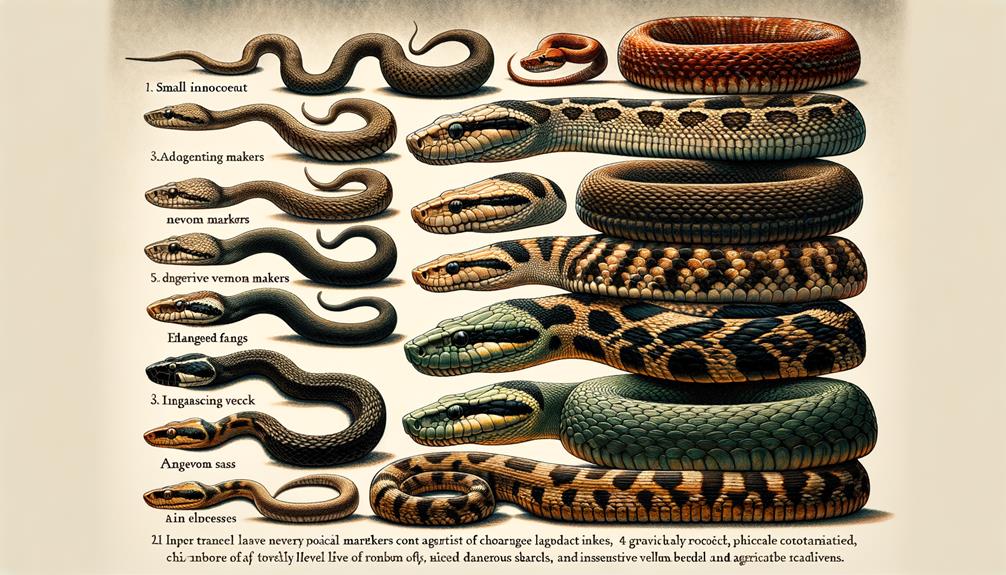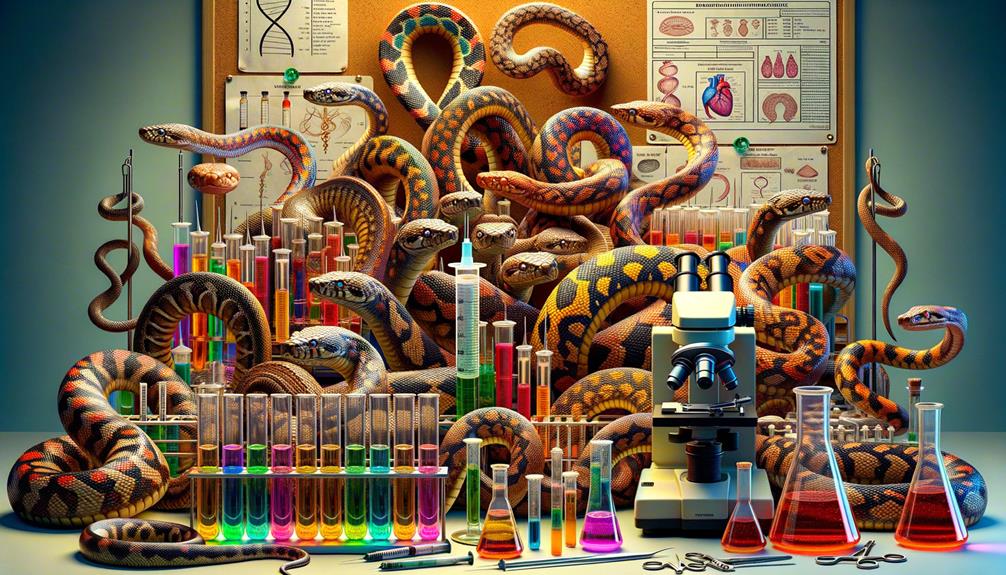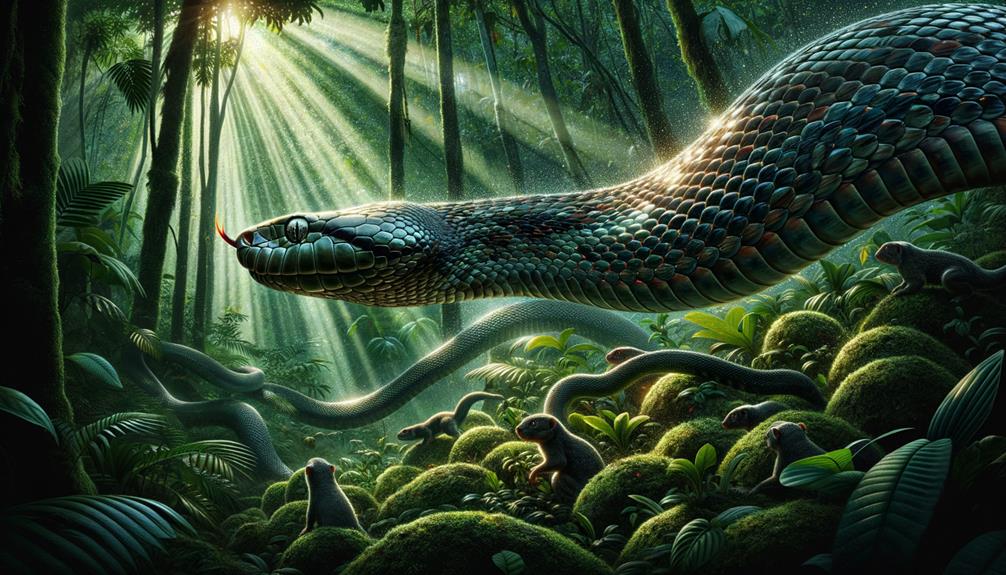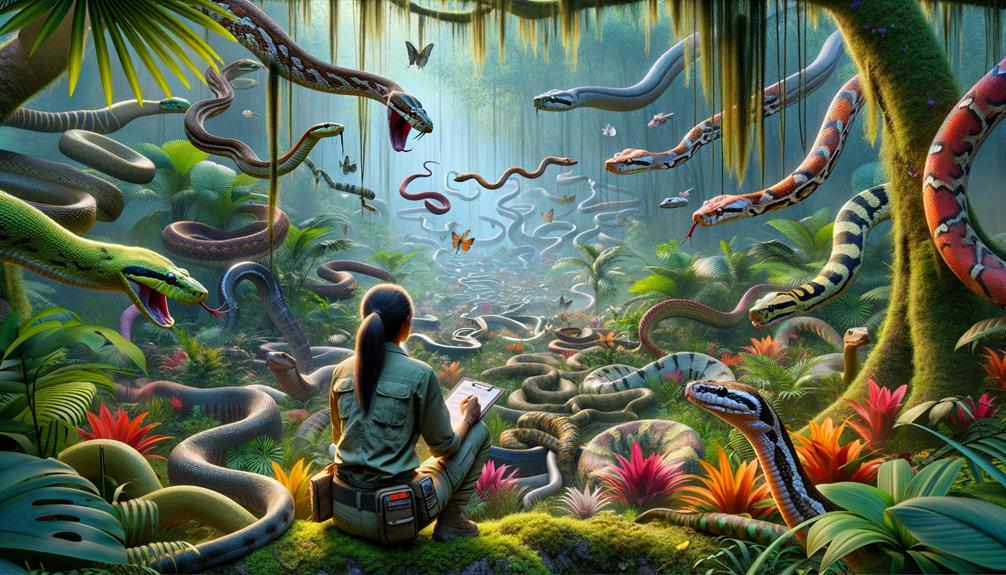Research shows that bigger snakes generally pose more risks due to their impressive strength, stronger venom, and capacity to take down larger animals. These hefty serpents often target more nutritionally rich prey, which can upset local wildlife populations. They're also tougher to manage, requiring higher doses of control substances. On the flip side, while smaller snakes might seem less threatening, they can be trickier to catch and handle due to their behavior. Understanding these size-related differences is key for creating effective safety plans and conservation strategies. These factors play a big role in both keeping people safe and maintaining nature's balance.
Research Findings
New research links snake size to potential human risk. Digging into the data, I found that a snake's size significantly impacts its hunting habits and prey choices. Take the brown tree snake, Boiga irregularis, for example. This hefty reptile poses a greater threat due to its ability to take down larger prey. On Guam, where it's not native, this snake has caused major ecological upheaval.
My research suggests bigger snakes typically go after prey that offers more nutritional bang for their buck – often small mammals, birds, and even other reptiles. This targeted hunting can really shake up local wildlife populations, throwing ecosystems off balance. The brown tree snake's impact on Guam shows just how much damage a large invasive snake can do.
These findings highlight why understanding snake size matters. It helps us predict potential threats from these predators. This knowledge is key for developing effective conservation plans and managing risks from non-native species, protecting both people and local ecosystems.
Size and Mortality

Big snakes pack a bigger punch when it comes to danger. Their size gives them an edge in strength, more potent venom, and the ability to take down larger targets, including people. On the flip side, smaller snakes aren't as threatening. They typically can't produce as much venom and aren't as physically imposing. This size difference plays a key role in how risky an encounter with a snake might be. It's worth noting that while size is a factor, other elements like species and habitat also influence the level of danger a snake presents.
Larger Snakes, Higher Risk
Big snakes pack a bigger punch when it comes to bites. Their size directly impacts how bad the bite can be. These larger reptiles not only carry more potent venom but can inject more of it, leading to serious tissue damage and widespread effects in the body. They often strike higher up on the body, like the legs, while smaller snakes typically go for the feet.
If you're unlucky enough to get bitten by a big snake, you'll likely need more antivenom. This means longer hospital stays and heftier medical bills. The sheer bulk of these snakes allows them to inject venom deeper, which can result in severe local reactions and, sadly, a higher chance of death.
Check out this breakdown:
| Snake Size | How Bad the Bite Is | Amount of Antivenom Needed |
|---|---|---|
| Small | Mild to Moderate | Low |
| Medium | Moderate to Severe | Moderate |
| Large | Severe | High |
Simply put, the bigger the snake, the bigger the health risk. Knowing how snake size relates to bite severity is key for proper medical care and treatment.
Small Snakes, Lesser Threat
Smaller snakes typically aren't as dangerous as their larger relatives. Their bites usually cause milder symptoms and rarely lead to death. The size of a snake plays a big role in how much of a threat it poses. Smaller snakes simply can't produce or inject as much venom, which means their bites are often less severe.
You're more likely to run into smaller snakes because they're widespread and often live close to humans. But these encounters rarely end badly. This is mainly because the venom and bite mechanics of smaller snakes are designed to take down small prey, not harm large animals like humans.
The build of smaller snakes is also less scary, and they tend to be less aggressive when defending themselves compared to bigger snakes. This difference in behavior contributes to their lower risk. Understanding these factors helps us see that while all snakes deserve respect, smaller ones aren't typically a major threat.
This balanced view allows us to appreciate these fascinating creatures while keeping a safe distance. It's about finding a middle ground where we can coexist with snakes without unnecessary fear.
Toxicant Treatment Impact

Snake size plays a big role in how well toxicants work on them. You really need to get the dose right for it to be effective. Bigger snakes need more acetaminophen, so careful measurement is key for both getting results and staying safe. It's also crucial to handle these substances properly. Mishandling can be risky, so taking precautions is a must.
When dealing with these toxicants, handlers need to be extra careful. The risks aren't just to the snakes – people can get hurt too if they're not mindful. That's why it's so important to follow safety protocols to the letter.
Getting the right dose is a bit of a balancing act. Too little won't do the job, but too much could be dangerous. It takes skill and experience to get it just right, especially when you're dealing with snakes of different sizes.
Toxicant Efficacy on Snakes
Studying how aerial toxicants affect invasive snakes means looking closely at how snake size, behavior, and location impact their vulnerability to acetaminophen. These factors work together to shape the success of control efforts and help make toxicant treatments as effective as possible.
Big snakes usually need more acetaminophen to be affected. This size-based dosing is key to making sure the toxicant works. How active snakes are and where they live also matter a lot. Snakes that move around more or live in certain areas might come across the toxicant more often, which can change how many die.
Let's break down how these factors interact:
| Factor | Effect on Treatment Success |
|---|---|
| Snake Size | Bigger snakes require larger doses |
| Movement | Active snakes encounter poison more frequently |
| Habitat | Where snakes live affects exposure |
| Health | Weaker snakes may be more susceptible |
| Behavior | Can predict survival after treatment |
Knowing these relationships helps target control efforts better. By adjusting strategies based on these factors, we can manage invasive snake populations more effectively, leading to changes in their numbers and types. It's crucial to keep watching and adapting our methods to keep them working well.
Size-Dependent Treatment Response
Snake size plays a big role in how they react to toxins like acetaminophen. Bigger snakes need more of the stuff to kick the bucket, so getting the dose right is crucial. Scientists have mapped out how brown treesnakes of different sizes respond to various doses, and it's clear that a one-size-fits-all approach won't cut it.
When it comes to wiping out these slithery pests, a few key things come into play:
- Size: The bigger the snake, the harder it is to kill. You've got to up the dose for the big boys.
- Health: A snake's overall condition matters. Well-fed, healthy snakes might shrug off doses that would flatten their scrawnier cousins.
- Behavior: How active a snake is and where it hangs out can make a difference. Some snakes might be more likely to run into the toxins than others.
- Population makeup: After a round of treatment, you might notice changes in what kinds of snakes are left. The survivors tend to share certain traits.
Getting this stuff right is a big deal for pest control folks. They need to know exactly what they're dealing with to make sure their efforts pay off. It's not just about dumping poison and hoping for the best – there's real science behind making sure we're targeting these invaders effectively.
Safety Measures for Handlers
Handlers need to be on their toes when dealing with toxic baits for snakes. It's not just about following a set of rules – you've got to really understand how different factors play into the mix. Take snake size, for example. Bigger snakes can handle more acetaminophen, as we've seen with brown treesnakes. This means handlers have to be extra careful and adjust their approach based on the size of the snake they're dealing with.
But it's not just about size. How active the snake is and where it hangs out also affect how it reacts to the toxicant. These factors help us fine-tune our safety measures. After we've treated an area, we often notice changes in which traits are linked to snake deaths. This shows us that we need to be ready to switch up our game plan as snake behavior and size shift over time.
The key here is flexibility. As the snake population changes, our safety protocols need to keep pace. It's a constant process of observing, learning, and adapting to make sure our handlers stay safe while they're out there doing their job.
Foraging Behavior

Brown Treesnakes come in different sizes, and the bigger ones tend to eat a wider variety of animals. This has a serious impact on Guam's wildlife. My studies show that as these snakes grow, they become more adventurous eaters, munching on everything from small critters to larger local and domesticated animals. This broad appetite not only throws the local ecosystem out of whack but also makes it harder to control these unwanted visitors.
Here's what I've noticed:
- Big snakes aren't picky: They'll eat small and large prey, unlike their smaller relatives.
- Native species take a hit: When big snakes can eat larger animals, it puts more pressure on local wildlife, including endangered species.
- Size matters for spread: The mix of snake sizes in an area affects how they spread and settle in new places.
- Tricky to manage: Smaller snakes don't fall for the usual rodent bait traps, making them harder to catch.
Body Condition

A snake's physical state plays a key role in its ability to survive, breed successfully, and hunt efficiently. Looking at different snake species, we can see that their overall health depends on things like fat stores and muscle development. These features help snakes get through times when food is scarce and ensure they can reproduce.
As snakes grow from young to adult, their bodies change in ways that affect their overall condition. Their metabolism shifts, changing how they use and store energy. Young snakes often burn energy faster, so they need to eat more often to stay healthy. Adult snakes, on the other hand, can usually go longer between meals because their bodies use energy more slowly.
The range of sizes you see in a group of snakes can tell you a lot about how well that species is doing. A healthy population will have snakes of many different sizes, showing that they're growing well and having babies. If you see mostly snakes of one size, it might mean something in their environment is causing problems.
Management Implications

Snake size significantly influences management strategies for control and conservation. For invasive species, size is a key factor in determining the best approach. Larger snakes not only require more antivenom for bites but also present unique challenges for control efforts.
Research points to four main management considerations related to snake size:
- Control Methods: Aerial toxicant treatments can be tricky, as their effectiveness varies with snake size, body condition, and behavior. Monitoring these factors across large areas is crucial.
- Protective Equipment: In rural areas, wearing boots can greatly reduce bites from smaller snakes, which often strike at feet.
- Population Control: Efforts to intercept, suppress, or eradicate snake populations must account for size variations. Different sizes pose varying risks and require tailored strategies.
- Stress Indicators: Analyzing stress responses in the context of invasion history helps refine management and conservation tactics, particularly for species like the brown treesnake.
These detailed insights are vital for developing practical, science-based strategies that can adapt to changing conditions.
Frequently Asked Questions
Do Small Snakes Have More Venom?
Surprisingly, some of the tiniest snakes can deliver a powerful dose of venom. Many smaller species possess highly toxic venom, making them just as hazardous as their larger counterparts, if not more so. This unexpected potency serves as a reminder that size doesn't always indicate the level of danger when it comes to venomous creatures.
Should I Be Worried if I See a Baby Snake?
When spotting a baby snake, it's smart to pause and assess the situation. Many young snakes pack a venomous punch and can be less predictable than their adult counterparts. The best approach is to keep your distance and reach out to local wildlife experts. They can help identify the species and offer guidance on what to do next. Remember, not all snakes pose a threat, but it's always better to err on the side of caution when dealing with wildlife.
Which Two Snakes Have the Same Mortality Percentage?
When comparing the deadliness of different snake species, two stood out with matching fatality rates. The Eastern Brown Snake and Coastal Taipan both pose a serious threat, with about half of untreated bites proving fatal. This underscores the critical need for swift medical care after an encounter with either of these dangerous reptiles.
What Percent of Snakes Are Harmful?
Snakes often get a bad rap, but the truth might surprise you. Only about 15% of snake species actually pose a threat to humans. This means the vast majority are harmless creatures, simply going about their business in the natural world. While it's wise to be cautious around unfamiliar snakes, understanding which ones are dangerous can help us appreciate these fascinating animals more fully. By learning to identify the risky few, we can better enjoy our time outdoors without unnecessary fear. This knowledge allows us to coexist peacefully with snakes, respecting their role in the ecosystem while staying safe ourselves.



